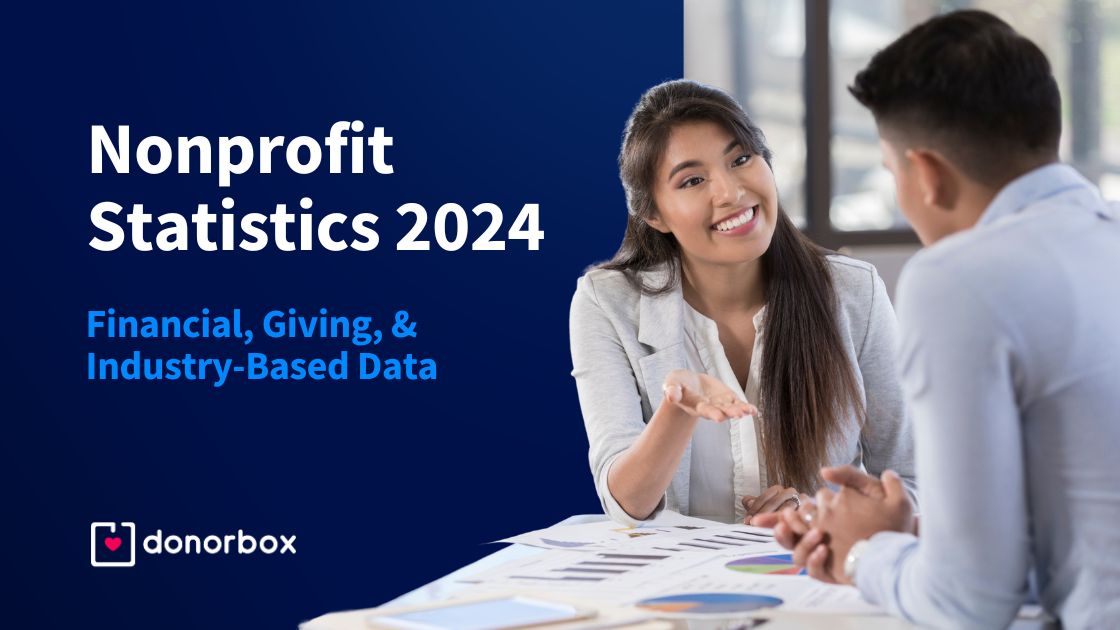The nonprofit sector is said to be the third-largest employer in the United States. Many people may be surprised that an industry of charities could make enough to employ that many people. However, with over 1.48 active 501(c)(3) nonprofit organizations, the number of employees shouldn’t be a surprise.
The nonprofit industry has many surprising statistics that may open people’s eyes to the growth of specific industries, giving tendencies of generations, and where the future of nonprofits is headed.
The following important stats may help your organization find the right target market and the best way to reach them.
1. Charitable Giving Statistics
Charitable giving can feel like a guessing game, and too often, that is precisely what nonprofits do when developing campaigns and communicating with donors.
1.1 These statistics can help your nonprofit develop a roadmap and fundraising plan.
- Individual donations to nonprofit organizations rose every year after 2012 until 2022 when the industry faced a 1.7% decline.
- At the same time, foundations and corporation gifts rose. By 2022, Donor-advised funds DAFs totaled $23 billion and 3.5 million grants.
- 37% of those with a household income between $70,000 and $200,000 are open to solicitation.
1.2 The following statistics show how unaware people in the US are of nonprofit organizations.
- 62% of Americans are unaware of the fact that giving is declining
- Only 5% of individuals believe they have received services from nonprofits
1.3 Some other interesting charitable giving stats include –
- According to the IRS, the most charitable people in the US live in Utah. The other top 10 states comprise Mississippi, Alabama, Tennessee, Georgia, South Carolina, Idaho, Oklahoma, Arkansas, and North Carolina.
- Nonprofits with monthly recurring programs receive an average of $52 every month.
- Monthly recurring donors give 42% more than one-time donors.
So, if you’re concerned about whether people are still giving, rest assured they are.
2. Income (AGI Based) Statistics
The breakdown of how individuals are giving according to their income can be fascinating. The average donation in the US in 2020 was $737. The following statistics can help give your organization an overview of who you should target and how much you can solicit from your donors.
2.1 When it comes to Average Gross Income (AGI) –
- Only 7.5% of people making less than $50,000 per year claim charitable deductions. The average charitable donation from these individuals is $2,588, which equals 8.45 of their adjusted gross income (AGI).
- 35% of those making $100,000 to $500,000 claim charitable deductions averaging $3,305. This group raises the most money for nonprofit organizations in the US, but give only 2.9% of their AGI.The highest income holders at $10,000,000 or more, average $2,813,343 in charitable deductions. 94.6% of individuals with this level of wealth claim charitable deductions. people earning less than $15,000 made an average charitable donation of $1,471, and this must not be ignored.
2.2 Charitable deduction as a percentage of AGI:
- under $50,000 8.4%
- $50,000 – $100,000 4.5%
- $100,000 – $500,000 2.9%
- $500,000 – 2 million 3.1%
- 2 million to 10 million 4.4%
- 10 million or more 9.3%
3. Generational Statistics
Now that we know what people give according to income, we also need to address generational differences. Once again, the statistics may surprise you.
3.1 Gen Z

Gen Zs will represent 82 million people in the US by 2026 (the largest generation) and they’re considered the tech-addicted social justice warriors. Some interesting facts about them include –
- Gen Z gives the most to social and environmental issues.
- According to a study by PayPal Giving Fund Canada, 93% of Gen Z and Millenials plan to make a financial donation in 2024.
- 91% of Gen Z plan to volunteer for nonprofit organizations.
A nonprofit should target this generation because of potential success in finding passionate advocates, volunteers, influencers, and donors.
3.2 Millennials
Millennials now account for 25.9% of the US population. You’ve likely heard that younger generations give less, but that depends on how you look at it.
- 84% of Millennials give to charity with an average of $481
- 60% of Millennials plan to give more to nonprofits in 2024 than in 2023
- This generation focuses more on disaster relief
- 40% of Millennials are enrolled in monthly giving programs
- 46% of Millennials donate to crowdfunding campaigns
- 64% of Millennials volunteer locally, 9% volunteer internationally
- Millennials are more likely to give via sponsored initiatives and mobile and will watch online videos before giving.
The amount of gifts for this generation is lower than for older generations, but the number of donors coming from this age group is significant.
Millennial donors are more likely to use mobile devices for research, donating, and advocating for a cause. To reach this generation, you’ll want to look at including digital wallet apps like Venmo, Apple Pay, Google Pay, etc.
Donorbox UltraSwift™ Pay makes giving a breeze for your donors. It eliminates the need for them to input their personal details and lets you use the power of digital wallets to make the donation process fast, secure, and convenient.
3.3 Gen X
The Gen X generation is 20.4% of the US population and 59% of them donate. This may discourage you from focusing on this population, but that would be a mistake.
- 49% of Gen X donors are enrolled in monthly giving programs
- 45% of Gen X donors give to crowdfunding campaigns
- 64% volunteer locally, 8% internationally
- 56% of Gen X donors attend fundraising events
This generation of donors should be your best choice for crowdfunding and peer-to-peer fundraising. Convince 1 donor to start a campaign that reaches 10 of their friends and you could raise over $7,000.
It’s best to contact Gen X via text message or phone. They are also likely to check their emails, and 59% are inspired to donate in response to messages and images on social media.
3.4 Baby boomers
In the past, the Boomer generation has dominated most industries for years due to their size. Boomers have dropped from the largest demographic to 23.6% of the US population. While this demographic has gotten smaller, it still consists of a large donor block.
- 72% of boomers donate annually, which makes them a force to be reckoned with.
- Boomer donors give an average annual gift of $1,212.
- 49% of Baby Boomers are enrolled in monthly giving programs
- 35% donate to crowdfunding campaigns
- 58% attend fundraising events
- 71% volunteer locally, 9% internationally
Boomers are more likely to answer phone calls, check email, and use text messages, and social media.
3.5 Silent generation

The silent generation makes up only 11.8% of the US population, but their average annual gift of $1,367 still significantly impacts the nonprofit sector.
- 88% of the silent generation gives to charity
- 30% of these donors have given online in the last 12 months
- Silent Generation donors are more likely to give in-kind donations
Silent Generation donors respond best to phone calls and direct mail. Your organization can strengthen relations with these donors by incorporating planned giving.
4. Industry-Based Fundraising & Giving Statistics
Next, we’ll take a closer look at how donors are giving to different nonprofit industries such as religious, school, homeless, food-related, etc.
4.1 Religious
- Religious organizations have had to face significant changes to how they solicit and raise funds.
- 49% of donations made to churches were given via credit card
- 60% of churchgoers are willing to give to their church digitally
- 67% of churches report using online giving
- Congregations that offer online giving reported higher per capita giving ranging from $2,052 to $2,428.
- Congregations that don’t offer online giving reported per capita giving at $1,809
- 3 out of 4 people who don’t go to church donate to nonprofit organizations
- 37% of regular church attendees don’t give money to the church
- According to a Giving USA report, donations to churches made up 27% of all charitable giving. Religion was the only sector in the report where giving went up.
4.2 Human services
Some interesting facts and data about human services giving include –
- Human service organizations saw an 8% decrease in donations when adjusted for inflation
- Human services received 14% of all US donations
- Human services ranked as the top priority for donors in 16 cities
- 8 of these cities are on the East and West coasts
- 6 out of 8 of these cities used to cite education as the top priority for donors
4.3 Education
In 2022, education received 13% of all US donor funds and saw a 10.7% decrease in donations when adjusted for inflation. But Donors gave $58 billion to higher ed in the 2023 academic year, with mega gifts up despite an overall decline in education-related giving.
5. Online & Mobile Giving Statistics

Every demographic other than the Silent Generation has shown a great interest in online giving. Online giving from individuals for one-time donations declined 12% in 2022. Still, there are various online giving types and campaigns that have increased their effectiveness. Other forms of online campaigning have grown in popularity within and across demographics.
- 46% to 47% of Gen Z and Millennial donors use QR codes on direct mailing to support their favorite charities.
- Monthly giving rose 11% and accounted for one-third of online giving.
- 71% of Americans have donated to charity at the register at least once.
- 66% of donations made at the checkout are $2 or less.
- 2% of donors give at the checkout because they recognize the organizations.
- 79% of Americans who donate at checkout feel positive afterward.
- For every 1,000 email subscribers, nonprofits have 236 mobile subscribers – an 11% increase from 2021.
With this increase, nonprofits averaged 21 texts per subscriber (primarily advocacy messaging).
- 57% of nonprofit website traffic came from mobile and tablet devices, but 75% of revenue came from users on desktop devices.
6. Volunteering Statistics
Since the Covid-19 pandemic, volunteer statistics have changed. The following details can help nonprofits plan and recruit for their volunteer needs.
- Volunteers donate almost 50 hours of their time on average
- The average age of volunteers in the US is 42
- More volunteers are women (64%) than men (36%)
- 39.9% of volunteers in the US were parents
- Corporate volunteerism has increased the number of skilled volunteers for nonprofits
- The average corporate volunteer participation rate is 33%
- 56% of nonprofit volunteers regularly attend fundraising events
- 67% of donors are nonprofit volunteers
Despite these statistics, volunteer leaders rate recruiting volunteers as one of the top challenges in 2023.
7. Corporate Giving Statistics

In 2022, corporate giving grew by 3.4% totaling $29.48 billion. Corporations give to nonprofit organizations in many ways and for many reasons. When soliciting corporate donations, it’s best to take time to build partnerships with these organizations to ensure healthy, long-term results.
- Corporations account for 21% of all revenue given to charity ($1 for every $5)
Corporations have increased their interest in giving to nonprofits due to a strong influence from younger employees. Companies have started to offer more matching gifts and volunteer opportunities.
70% of nonprofits cite board involvement in fundraising as a significant challenge. Building corporate partnerships that can increase the revenue of the organization can be an excellent way to increase the involvement and effectiveness of your board.
Final Thoughts
Demographics, religion, and annual income can all play a part in why donors give. These statistics can help nonprofits determine which groups best fit their donor base, how they should be communicating, and what are the best ways to fundraise. We also have another article discussing year-end giving statistics to help you make smart and informed strategies for the giving season!
For more blogs, guides, tips, and free resources, check the Donorbox Nonprofit Blog. Subscribe to our newsletter to have a list of our best resources delivered to your inbox every month.
Donorbox can help nonprofits collect donor information, segment their donors, and note communication details to create donor management plans for each type of donor. Learn more about our Donor Management feature here.
Donorbox also helps nonprofits of all types raise funds online with simple-to-use, affordable, and powerful fundraising features including Crowdfunding, Peer-to-Peer fundraising, Text-to-Give, Memberships, Events, Recurring Donation Forms, Customizable Donation Pages, and more.








